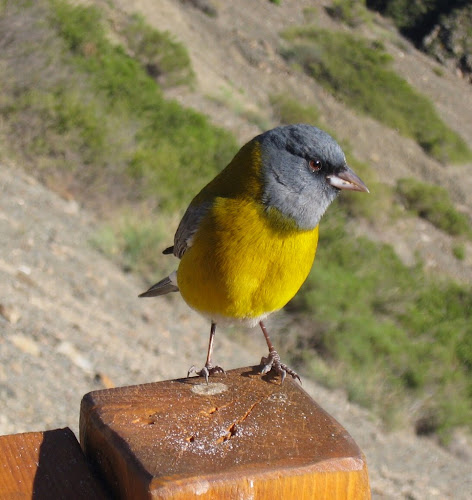There's a small yellow finch that has all the traits of a crumb scrounging sparrow. That also has a "cheep-cheep" which resembles that of an annoying malfunction on a bicycle. Insistent, regular, such that it can easily equate to the cadences of a wheel, pedal or chain. As a crumb hunter and habituated to humans it will keep pace with a slow pedalling, attitudinally afflicted, climbing cyclist. Convincing same that something is mechanically wrong, at a time when every ounce of energy needs to be converted into accumulating height and distance. So I stop, but the "cheep-cheep" doesn't. Drafted bird. It's not alone. There's another bird that flies at night, in what appears to be vast circles, whose call is that of a car's reverse warning. Not an issue when we're camped up well away from traffic. But when a camping ground's design allows for free and unfettered car access, you can wake in that ungodly pre-dawn confusion, with a racing heart, only to realise it's only that unnamed bird again.
A cicada on the navigator's back carrier has now utterly convinced me that she has a puncture. The fizzle from its vibrating legs matches the rolling rotation of her wheel. The suggestion was already seeded in my mind. We're in thorn country, the roadside verge is sprinkled with glass shards and exploded tyre wire. We're collecting punctures. I've repaired more holes on this trip already, than the total for the last three journeys. A problem probably not enhanced by being cheapskate Scots. We decided to wear out a set of part used tyres. A mean decision that has meant that when my rear blistered, I got to use our spare folding one. The one that's traveled over fifty thousand kilometres in a back pannier, awaiting this one moment of fame. It's remarkable that it hasn't perished yet, or succumbed to a mouse.
Whilst these incidents are amusing in themselves, the real malfunctioning fauna are those that are now habituated to human contact. The slogan "a fed bear is a dead bear", is well known, if poorly remembered in Canada. The same is true around the campgrounds of the Andes. "Don't feed the Zorros". I set to, to light a fire and as if by telepathic magic, two foxes materialise, sitting silent, expectant on their haunches. Now I remember what zorros are. The iguana has already hauled away a bag of banana skins that I thought well secured from animal attack. Rodent and ants being the usual culprits, so I hadn't anticipated a foot-long lizard's visit.
Then there are the animals that have adapted to the human built environment, adopting the street furniture for their own needs. Who requires a cliff when the city fathers have planted palm trees or have erected lighting columns? These have a further attraction as they come with a photovoltaic ledge. Nest sites with amenities. In Arica, it's not the pigeon that poops a building, but cormorants. They cruise low, up and down the main pedestrian street, as if in a seaside canyon. At first encounter I question my identification. Evolutionary prehistoric, little evolved over five million years, they look like they are the original Jurassic avian dinosaur. They sound as if my rear wheel bearings requires a cartridge of grease.
And now there's a report on ants and their beneficial contributions to society. It's been calculated that they're responsible for consuming 60,000 hot dogs per year from the streets of New York. Two-thirds of each 'dog' eaten in just one night. Having left a part eaten tin of corned beef, double wrapped, overnight and seen the effects in the morning, frankly I'm not surprised. In this instance more functioning fauna as they're chompings in the quiet of the night can be equated to any cycle malfunction.


